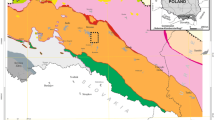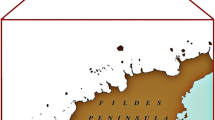Abstract
Direct correlation have been observed between certain trace element and hydrocarbon anomalies in the near subsurface soils of Vindhyan basin, India. This relationship with hydrocarbon is very useful in hydrocarbon exploration. 52 soil samples from Vindhyan basin were collected from a depth of 2.5m. All the soil samples were analyzed for light hydrocarbon, isotope and trace element concentrations. The adsorbed light gaseous hydrocarbon analyses show the presence of methane (8–328 ppb), ethane (0–27 ppb) and propane (0–11 ppb) respectively and these values indicate the presence of hydrocarbon micro-seepage in the study area. The carbon isotopic values determined for methane and ethane for these soil samples are (−26.41 to −47.70 ‰ PDB) and (−20.07 to −35.30 ‰ PDB) respectively and they are thermogenic in nature. The trace element concentrations of nickel (33–220 ppm), vanadium (72–226 ppm), copper (20–131 ppm), chromium (94–205 ppm), zinc (66–561 ppm) and cobalt (9–39 ppm) have higher than the normal concentrations in soils. Trace element concentrations are used to plot with the data obtained from light gaseous hydrocarbon concentrations and carbon isotopic values of soil samples of the Vindhyan basin. Trace element anomalies have been observed around the hydrocarbon anomalies in the study area.
Similar content being viewed by others
References
Alekseev, F.A., Gottikh, R.P. and Sundukov, G.D. (1963) Results of radio geo chemicals investigations of the Kyurov-Dag Oil Field, in Geophysical Abstracts, pp.728–729.
Nissenbaum, A. and Swaine, D.J. (1976) Organic matter-metal interactions in recent sediments, the role of humic substances. Geochem. Cosmochim. Acta, v.40, pp.809–816.
Shandilya, A.K. (2008) Natural leakages from bore wells in the vindhyan super group, sagar and Damoh districts, Madhya Pradesh (India), Himalayan Geol., v.29(2), p.193.
Balram, V., Ramesh, S.L. and Anjaiah, K.V. (1996) New trace element and REE data in thirteen, GSF reference samples by ICP-MS. Geostandards NewsLetter, v.20, pp.71–78.
Banerjee, S. and Kumar, S.J. (2005) Microbially originated wrinkle structures on sandstone and their stratigraphic context: Paleoproterozoic Koldaha Shale, central India. Sediment. Geol., v.176, pp.211–224.
Bernard, B.B. (1978) Light hydrocarbons in marine sediments, Ph.D. dissertation, Texas A&M University, College Station, p.144.
Bose, P. K., Sarkar, S., Chakraborty, S. and Banerjee, S. (2001) Overview of the Meso- to Neoproterozoic evolution of theVindhyan basin, central India (1.4–0.55 Ga). Sediment. Geol., v.141, pp.395–419.
Chakraborty, P.P. (2004) Facies architecture and sequence development in a Neoproterozoic carbonate ramp: Lakheri Limestone, Member, Vindhyan Supergroup, Central India, Precambrian Res., v.132, pp.29–53.
Chanda, S.K. and Bhattacharya, A. (1982) Vindhyan sedimentation and paleogeography: post-Auden developments. In: K.S. Valdiya, S.B. Bhatia and V.K. Gaur (Eds.), Geology of Vindhyanchal. Hindusthan Publishing Corporation, New Delhi, pp.88–101.
Duchscherer Jr., W. (1983) Geochemical Hydrocarbon Exploration — A new/old Exploration Tool. Jour. Geochemical Explor., v.19, p.335–336.
Duchscherer Jr., W. (1984) Geochemical Hydrocarbon Prospecting, Pennorthwestell Publ. Co., Tulsa, OK.
Madhavi, T., Kalpana, M.S., Patil, D.J. and Dayal, A.M. (2011) Evidence for a relationship between hydrocarbon microseepage and trace metal anomalies: an implication for petroleum exploration. Geosciences Jour., v.15, pp.197–206.
Naqvi, S.M., Khan, R.M.K., Manikyamba, D., Ram Mohan, M. and Khanna, T.C. (2006) Geochemistry of Neo-Archean high-Mg Basalts, boninites and Adakites from the Kustagi — Hungund greenstone belts of the eastern Dharwar Craton (EDC): implication for the tectonic setting. Jour. Asian Earth Sci., v.27, pp.25–44.
Petrovic, A., Khan, S.D. and Chafetz, H.S. (2009) Remote detection and geochemical studies for finding hydrocarbon — induced alterations in Lisbon Valley, Utah, Marine and Petroleum Geology, v.25, pp.696–705.
Pixler, B.O. (1969) Formation evaluation by analysis of hydrocarbon ratios. Jour. Petrol. Tech., v.21, pp.665–670.
Rao, T.G. and Govil, P.K. (1995) Merits of using barium as heavy adsorber in major element analysis of rock samples by X-ray Fluorescence: new data on ASK-1 and ASK-2 reference samples. Analyst, v.120, pp.1279–1282.
Schoell, M. (1983) Genetic characterization of natural gases. Amer. Assoc. Petrol. Geol. Bull., v.67(12), pp.2225–2238.
Schumacher, D. and Abrams, M.A. (Ed.) (1996) Hydrocarbon Migration and its Near-Surface Expression. Amer. Assoc. Petrol. Geol. Mem., v.66, pp.71–89.
Siegel, F.R. (1974) Applied Geochemistry. John Wiley & Sons, pp.139–141.
Khan, S.D. and Jacobson, S. (2008) Remote sensing and Geochemistry for detecting hydrocarbon seepages. GSA Bull., v.120, pp.96–105.
Staunton, S. (2002) Direct and Indirect Effects of Organic Matter on Metal Immobilization in Soil. Developments in Soil Sci., v.28A, pp.76–97.
Tedesco, S.A. (1995) Surface geochemistry in petroleum exploration, New York, Chapman & Hall, 256p.
Vinogradov, A.P. (1959) Geochemistry of Rare and Dispersed Chemical Elements in Soils (translated from Russia) Consultant Bureau, New York, 209p.
Wang Duoy, Deng Meizhou, Liu Yinghan, Liu Yawei, Li Xingyun and Lu Renqui (2008) Discovery of the metal trace elements in natural gas and its ecological environment significance. Earth Sci. Frontiers, v.15(6), pp.124–132.
Wang D.Y., Deng, M.Z. and Ye, B. (2006) Studies on environmental issues caused by hydrocarbon leak in XC gas field. Natural Gas Industry, v.26(7), pp.133–135.
Yang, F.G, Tong, C.H. and Wang, H.N. (2000) Mechanism of geo gas substance transportation on oil and gas field. Geochim. Cosmochim Acta, v.29(5), pp.445–446.
Zhao, B.L. and He, Z.X. (2005) Non-seismic technique for direct oil-gas detection and its exploration practice. China Petroleum Exploration, v.6(63g), pp.29–38.
Author information
Authors and Affiliations
Corresponding author
Rights and permissions
About this article
Cite this article
Lakshmi Srinivasa Rao, P., Srinu, D., Rasheedd, M.A. et al. Correlation of trace elements with hydrocarbon microseepage. J Geol Soc India 82, 666–674 (2013). https://doi.org/10.1007/s12594-013-0205-5
Received:
Accepted:
Published:
Issue Date:
DOI: https://doi.org/10.1007/s12594-013-0205-5




